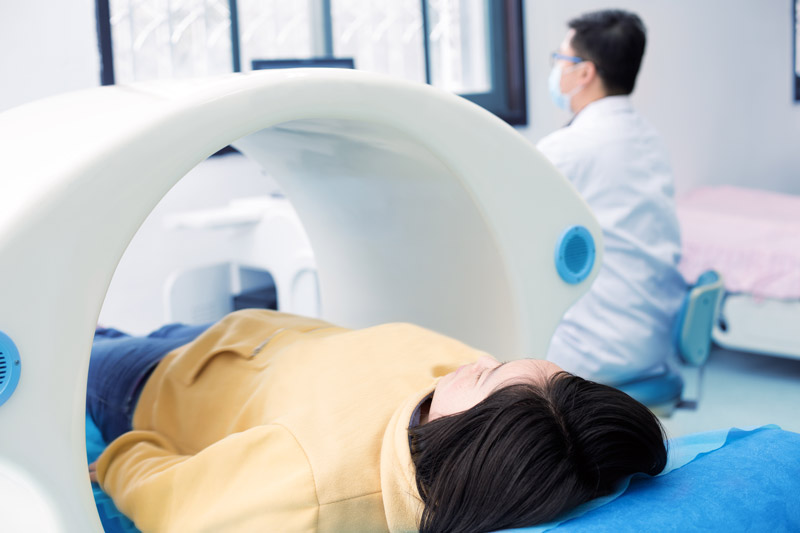A whole-body bone scan is a nuclear medicine test to check your bones for issues or changes. You receive an injection of a substance called a radiotracer. The radiotracer collects in areas of irregular activity and highlights these areas on an imaging scan. It’s painless and safe for most people.

A whole-body bone scan is a test to check the health of your bones. Healthcare providers typically order this scan to check whether cancer has spread (metastasized) to your bones. You may also have a whole-body bone scan to help determine cancer stage (how advanced it is).
A whole-body bone scan is a type of nuclear medicine imaging scan. Providers use advanced technology that may sound complicated. But the tests are painless, effective and safe for most people.
Before the test, you receive an injection of a radiotracer (a substance that contains a small, safe amount of radioactive material). The radiotracer collects in areas of your bones where there are changes or irregularities. These areas appear brightly on an imaging scan, helping your provider pinpoint disease.
A whole-body bone scan can show damage or changes in your bones. The test doesn’t show your provider the cause of the damage or changes.
Your provider may use a whole-body nuclear bone scan as one of several tools when diagnosing conditions like:
Cleveland Clinic is a non-profit academic medical center. Advertising on our site helps support our mission. We do not endorse non-Cleveland Clinic products or services. Policy
A whole-body bone scan works by using a radiotracer injection. The radiotracer gathers in areas where cells show signs of change or irregular activity. Changes in cells could indicate cancer or other diseases. A large scanner called a gamma camera takes images of your body. The gamma images show “hot spots” or areas where the radiotracer has collected.
Your care team gives you specific instructions for a whole-body bone scan. Most people don’t need to do anything special. You can typically eat and drink as usual and take your regular medications unless your provider says otherwise.
You’ll need to remove any objects containing metal from your body, like jewelry or belts with metal buckles. Tell your provider if you have a metal joint implant, dental implant or pacemaker. They can help determine whether a whole-body nuclear bone scan is safe for you.
On the day of your scan, you should plan to be in the hospital or imaging center for several hours. During the test:
The test itself usually takes around 30 to 60 minutes. But you spend several additional hours in the hospital or imaging center while the radiotracer circulates in your bloodstream.
You can return home after a whole-body bone scan and resume your usual activities immediately, including driving. Your provider may instruct you to drink plenty of water for 48 hours to continue flushing the radiotracer from your system.
This is a safe test for most people. The radiotracer dose is so small that you don’t usually need to take special measures to avoid exposing others to radiation. You may need to stay an arm’s length away from higher-risk people for about 24 hours. This may include babies, children and pregnant people.
Tell your healthcare provider if you’re nursing, pregnant or think you could be. A whole-body bone scan isn’t safe for pregnant or breastfeeding (chestfeeding) people.
Most people have no side effects of a whole-body bone scan. The test isn’t painful, except for a minor sting or prick when the technologist injects the radiotracer. You may have some mild bruising or swelling in your arm where you received the radiotracer injection. This usually goes away within a few days.
A whole-body bone scan shows “hot spots” or areas of irregularity in your bones. The results can show areas of concern, but they won’t necessarily tell you the underlying cause. You’ll likely need more tests if your whole-body bone scan shows irregularities in your bones.
You don’t get the results of a whole-body bone scan immediately. It usually takes one to two weeks for your healthcare provider to share the results with you. You can ask your care team for a specific timeline after your test.
If your whole-body bone scan shows areas of concern, you may need more tests to find the culprit. You may have a:
Some providers use the terms “bone scan” and “whole-body bone scan” interchangeably. Sometimes, they use the term “bone scan” when using the test to look at only one specific joint or bone rather than your whole body.
People may also use the term “bone scan” when referring to DEXA scans. A DEXA scan is a type of X-ray that measures your bone density. It’s not the same as a nuclear medicine whole-body bone scan.
No, a whole-body bone scan isn’t the same as an MRI. An MRI uses magnets and radio waves to create three-dimensional images of your body. A whole-body bone scan uses radiotracers and a special gamma camera to get two-dimensional images of your body.
A note from Cleveland Clinic
It might feel a bit unnerving to hear that you need a whole-body bone scan. But the procedure itself is quick and straightforward — and it’s one of the best ways to check bone health throughout your body. Talk to your provider to learn more about this advanced imaging test.
Last reviewed by a Cleveland Clinic medical professional on 10/19/2023.
Learn more about our editorial process.
Cleveland Clinic is a non-profit academic medical center. Advertising on our site helps support our mission. We do not endorse non-Cleveland Clinic products or services. Policy